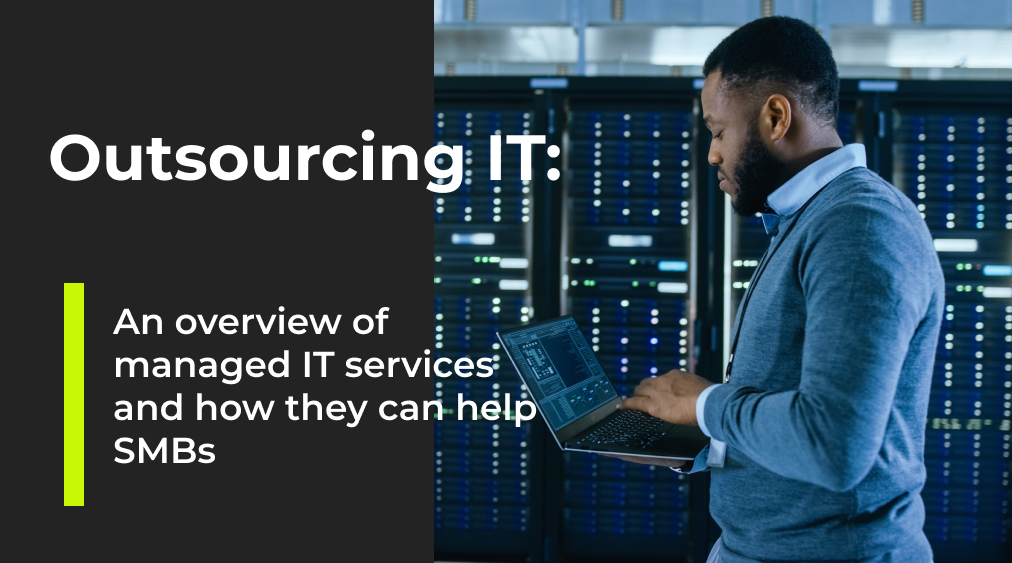
Outsourcing IT: An overview of managed IT services and how they can help SMBs
By Scott Putman
Discover the power of outsourcing IT services as economic pressures are closing in, cyber threats grow higher every day, and labour shortages prevent business growth.
Having a robust internal IT team can be one of the most powerful and helpful resources a business can have. However, realistically, not all businesses can actually afford to finance them—but that doesn’t mean they can’t gain and utilise the knowledge and skills they provide.
When IT systems become increasingly complex and technical innovation creates demand for skilled professionals, outsourcing managed IT services can help cut costs, enhance service quality, and free up internal teams to work on duties that are unique to their organisation—all without breaking the bank.
Unfortunately, IT outsourcing is rarely an easy task. Even with all the great advantages, drawbacks are possible, and hiring a managed services provider requires considering a series of factors to ensure success.
This article covers the benefits of IT outsourcing and what can go wrong, to provide an objective overview of managed IT services and how organizations can protect themselves when a third-party is in charge of their system and data security. With it, you’ll:
- Learn how managed IT services support business growth
- Understand how to use managed services SLAs to protect your organization
- Recognize the signs that your business needs a reliable managed services provider
What does “managed IT services” mean?

Managed IT services are based on the concept of outsourcing the responsibility of managing and maintaining IT services and equipment to a qualified and knowledgeable third party. You pay a monthly subscription for access to the service, and a third party manages the overall system functionality, infrastructure, and your organization's technical systems.
Often, the term "managed IT services" is used close to "cloud services." However, the terms refer to different concepts:
Cloud services are the software, platforms, and infrastructure that are hosted by a paid third-party service provider and made available to the business and/or its users through the internet. These on-demand services facilitate the access and flow of data to front-end clients, as well as back to the provider’s system, giving businesses powerful tools to store and retrieve data through means they could not otherwise establish or maintain in-house. However, the focus of these services is much more often about connectivity than security and maintenance, which rarely reduces the workload of many business’s internal teams.

Managed IT services, however, not only help businesses maintain and secure their infrastructure, but also include the management of your organization's workload, and can even include the management of the cloud platform you use to deliver your services.
What is included in managed IT services?
Managed IT services are designed to cover a vast number of needs and responsibilities often reserved for in-house teams in larger organizations. These services provide comprehensive support for most things IT-related, including the following:
Comprehensive cybersecurity
One of the most important features of managed IT services, comprehensive cybersecurity includes implementing numerous proactive and reactive security efforts designed to protect the data of the business and its users.
Emergency support, helpdesk services and on-demand IT support
For times in which time is a crucial factor, managed IT services will provide on-demand support for any emergencies as well as alternative options for support for less time-sensitive matters.
Data backup and disaster recovery
A critical piece of managed services, this means that data is properly backed up in several secure locations to ensure that, in case of a disaster, data can be properly recovered and restored across systems.
Remote monitoring and management
Actively watching the health and security of your data and infrastructure on
an ongoing basis.
Business continuity planning and management
In the case of potential disruption, this ensures that there is a plan in place that allows the business to continue functioning as seamlessly as possible for front-end users, even if there are issues that need to be resolved on the back end.
Software updates, upgrades, and patches
As businesses grow, so do their software and infrastructure needs. This service feature uses reliable protocols to make necessary updates across the system to maintain security and functionality.
Asset tracking and management
To maintain streamlined deployment and roll out necessary updates and even additional software installation, asset tracking and management standardizes and tracks a business’s hardware and software stack to minimize wasting time on tracking down assets within the greater system.
Business forecasting, planning, and purchasing advice/assistance
To provide the best path for a business moving forward, this service feature provides analysis of the current state of the business in relation to what IT or infrastructure-related elements may need to change upon further scaling, including adding or upgrading assets in the hardware and software stack.
Service-level agreements
Service-level agreements are documents that explicitly outline the terms of service of the partnership—and every good managed IT services provider will have them. These clearly outline the responsibilities of both the business procuring the services and the third-party service provider, so there’s no question as to what each team is required to handle respectively.
What managed IT services are not:
Most managed IT service providers offer a wide variety of services, but it’s worth noting that there are often limitations on the degree to which they are covered within a regular maintenance agreement. As you’ll see below, nearly all of these services can be performed, but many come with additional costs and are treated as separate projects.
Major software upgrades
Most managed IT service providers regularly handle smaller, more routine updates to a business’s established systems. While they can also perform major upgrades to new operating systems, databases, or management systems, these services are not often covered by monthly maintenance and support fees.
Physical installation and configuration
Managed IT services routinely cover updates, upgrades, and patches, but the physical installation or configuration of new equipment or major physical changes to hardware or physical network reconfiguration are often billed and undertaken as separate projects.
Hardware failures
More often than not, the labour needed to fix failed hardware is usually included, but the parts and outright replacement costs are not. Many MSPs will only include the labour if the machine is in-warranty, as out-of-warranty equipment may take an extraordinary amount of time to repair.
Hardware ageing
Nearly all managed IT service SLAs limit the support available for hardware or software that extends beyond a set amount of time, such as running multi-generation old operating systems or hardware, such as servers, that are more than six years old.
Location changes
Changing the physical location of a business and/or its on-site hardware is a huge task and outside the bounds of most agreements and the professional ability of managed IT service providers.
Physical disasters
While data backups and disaster recovery are normally a part of managed IT services as noted above, rebuilding after natural disasters such as floods, fires, earthquakes, power surges or failures, or even simple pipe leaks that cause damage, are not covered by standard maintenance agreements.
Managed IT services example
To see how IT services actually operate in real-life, consider this common scenario.
Robert owns a small but growing manufacturing business that relies heavily on data management and maintenance—but he doesn’t have the resources to hire a full team of IT professionals to help him and his current team to manage it all.
By hiring a managed IT service provider, Robert can continue operating his business and allow his team to focus on business-critical activities while a highly-trained team of IT professionals uses Robert’s established infrastructure to routinely update software, provide cybersecurity to minimize the risk of security threats and business disruption, and provide ongoing support and advice on how to grow his business with his tech stack—all at just a fraction of the cost.
The pros and cons of IT outsourcing explained
Of course, IT managed services are not a one-size fits all solution. While there are many pros to utilising this kind of service, there are several cons to be aware of as well—all of which need to be considered if you want to make the best choice for your business.
Pros
- Cost savings - As mentioned above, hiring a managed IT service provider is much more cost-effective than paying a team of internal employees to handle the workload as necessary, while still covering the work needed to operate a secure, reliable business.
- Enablement and flexibility - Instead of having a portion of your team having to take on additional responsibilities and take time and energy away from core business activities, you’ll have a full team of highly-trained professionals able to handle necessary work at a moment’s notice.
- Solve the skills gap - Realistically, many businesses don’t have the knowledge and skills within their internal team to be able to handle the rigours of managing all IT-related activities. By hiring a third-party, you’ll have a fully qualified and specialised team to handle the often arduous and intricate work that stems from having a complex system.
- Improved cybersecurity - Having a single individual with the skills to handle cybersecurity is a powerful resource—now imagine an entire team. By outsourcing to a group who are routinely trained on the latest security threats, protocols, and defensive methods, your business can operate confidently knowing you have a team of professionals looking out for you.
- Business growth, competitive edge, and efficiency - Even though a third-party is handling your IT work, you and your team will still gain a vast amount of knowledge of how everything in your ecosystem works simply by working alongside your service provider. This can allow you and your team to be more educated, efficient, and agile, and stay ahead of your competitors in the market without sinking additional financial resources.
- Job security - Hiring a third-party based on your needs means you won’t need to dramatically shift the positions and responsibilities of your internal staff, allowing you to avoid the impact of experiencing turnover for related roles.
- Take advantage of advanced technology - Instead of having to stay on top of—and potentially pay for—the latest tools, techniques, and training to keep your system properly secured, managed, and updated, you’ll have a high-functioning team equipped with the best technology in the industry at your disposal already included in the cost of hiring them.
Cons
- Lack of familiarity - Unlike your team, which has an intimate knowledge of your business’s inner workings, there’s often a steep learning curve to get a third-party provider up to speed. While many managed IT service providers have robust onboarding techniques to combat this, it’s still worth consideration if your ecosystem and/or business are particularly complex.
- Lack of coordination - Although many service providers have comprehensive methods for maintaining communication, there’s no accounting for coordinating two separate teams, even if around mutual goals. Like any cross-team collaboration, bottlenecks, miscommunications, and the like are still possible.
- Lack of flexibility - While you can much more easily train your own employees, expand or shift responsibilities, and so on, working with a third-party provider means you have to adhere to everything that’s been outlined in the SLA, which can make your collective efforts and their responses much less flexible.
- Quality of service - Most every managed IT service provider claims to be the best in the business or at least fully competent to handle a wide variety of IT needs, but there’s no guarantee that the one you hire will deliver service as expected. A bit of research can help combat this, but that doesn’t mean you’ll be satisfied with every provider you engage or employ.
- Lack of control - With in-house employees, you have much more control over responsibilities, timelines, protocols, and more. With a third-party provider, there’s much more compromise to be made, and that can have an impact on business operations.
How managed services SLAs can help protect your team
To ensure you and your team get the most out of your collaboration with your managed IT service provider, it’s best to agree on the terms of service before any work is undertaken—and that takes forming a proper service-level agreement (SLA).
In short, SLAs are documents that are mutually agreed upon by the business itself and the managed IT service provider in an effort to detail the responsibilities and expectations for both teams as clearly as possible. This minimises the potential for discrepancies, inconsistencies, and miscommunication between both parties while also establishing a legal basis for mutual operation.
Ideally, a good SLA will include:
Service descriptions
Detailed descriptions of the work involved and services rendered for/by each party.
Availability
This should denote the times and days the service provider is available for support and service requests, as well as a response time for each type of request, from emergency services to simple, non-time-sensitive requests.
Scheduled maintenance and monitoring
This establishes when and how frequently the service provider will be actively monitoring the system and providing scheduled maintenance.
Reporting
What services will be reported on, to what degree, and how frequently.
Protocols for managing and reporting problems and incidents
This is an important element that clearly outlines what protocols will be taken in case of a data/security breach, IT-related operational disruptions, and so on, so internal and external team members can respond accordingly.
Consequences for a breach of contract
Whether financial, compensatory work, or the termination of the partnership, this details the consequences for the service provider should they not meet the expectations and responsibilities outlined in the agreement.
If and how often the SLA should be updated, if necessary
This is self-explanatory but covers the technical aspects of the agreement so both parties are aware of the protocols necessary for updating the agreement should either party’s needs or abilities shift.
How to pick a managed IT services provider
Picking a managed IT service provider can feel like a tall task, but with the right information, it shouldn’t take more than a bit of research and consideration to make a good decision. While every business’s needs are different, most good MSPs will have these core criteria
- Experience and expertise - They’re well-established, have a proven track record of success and have experts on staff to provide insight on their services and abilities in relation to your business’s needs.
- Around-the-clock service - Security breaches, hardware failure and other issues can arise at any hour. A good MSP will make sure they’re resolved regardless of when it happens.
- Flexibility - They are able to effectively work with a variety of devices, integrations, environments and other forms of infrastructure your business is based on.
- Secure and reliable - They are up to date with the latest security tools and protocols and respond in a timely manner. If they’re not quick to reply to your questions as a prospective customer, it’s safe to assume they won’t likely be much better when you’re an actual client.
To get the best fit for your business, it’s a good idea to have a list of questions you need to ask on-hand, such as those regarding costs, experience, whether they can service your current infrastructure, availability, and so on, so you can appropriately compare your options on an equal basis.
Conclusion
As you can see, there are many significant benefits to hiring an MSP to address crucial IT needs within your business. However, as every business’s needs are different, there’s a lot to know and understand to ensure that you’re getting those needs met by a team of experienced professionals.




